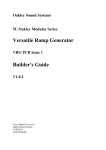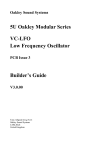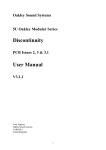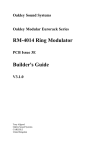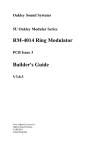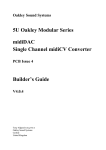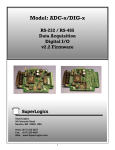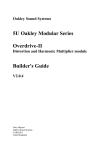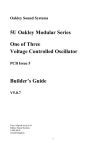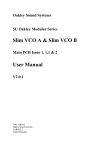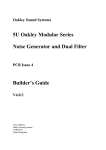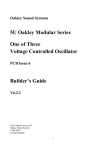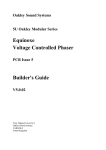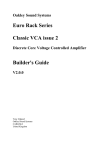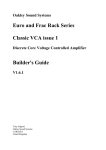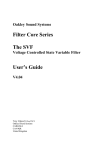Download SVCO-B Issue 2 Builder`s Guide
Transcript
Oakley Sound Systems 5U Oakley Modular Series Slim VCO B SVCO issue 2 & Octave Board issue 1 Builder's Guide V2.0.2 Tony Allgood Oakley Sound Systems CARLISLE United Kingdom Introduction This is the Project Builder's Guide for the Slim Voltage Controlled Oscillator variant B (SVCO-B) 5U module from Oakley Sound. This document is to be used with issue 2 main boards and issue 1 octave boards. In this document you will find a basic introduction to the board, a full parts list for the components needed to populate both boards and a list of the various interconnections. For the User Manual, which contains an overview of the operation of the unit and the calibration procedure, please visit the main project webpage at: http://www.oakleysound.com/s-vco.htm Also on the SVCO webpage is all the documentation for the SVCO-A variant. The A version is similar to the B version but lacks the octave and LFO switching. For general information regarding where to get parts and suggested part numbers please see our useful Parts Guide at the project webpage or http://www.oakleysound.com/parts.pdf. For general information on how to build our modules, including circuit board population, mounting front panel components and making up board interconnects please see our generic Construction Guide at the project webpage or http://www.oakleysound.com/construct.pdf. The first ever SVCO-B fitted behind a natural finish Schaeffer panel. This is an issue 1.1 SVCO main board and issue 1 Octave Board. 2 The issue 2 Slim VCO & issue 1 Octave Board On the SVCO printed circuit board I have provided space for the four main control pots. If you use the specified 16mm Alpha pots and matching brackets, the PCB can be held very firmly to the panel without any additional mounting procedures. The pot spacing on this board is different to many of our other 5U modules, instead of 1.625” it is 1.375”. Used in conjunction with smaller 20mm diameter knobs this still allows for an attractive module design and finger friendly tweaking. The design requires plus and minus 15V supplies. The power supply should be adequately regulated. The current consumption for the whole SVCO-B module is about +47mA and -38mA. Power is routed onto the main PCB by either our standard four way 0.156” MTA156 type connector or the special five way Synthesizers.com MTA100 header. The octave board takes its power directly from the main SVCO board via a 10-way ribbon cable. This ribbon cable also carries the reference voltage used by the octave board, the wiper voltage from the frequency pot and a voltage that controls the pitch of the SVCO. The main PCB has four mounting holes for M3 bolts, one near each corner. These are not required for panel mounting if you are using the three 16mm pot brackets. The main board size is 109mm (deep) x 123mm (high) and the octave board is 86mm (deep) 93mm (high). The Octave board sits above the main board on three 25mm hex threaded spacers. The Slim-VCO board has been laid out to accept connection to our Sock6 socket board. This small board speeds up the wiring of the six sockets and reduces the chances of building mistakes. The 10-way IDC interconnect carries signals and power between the octave board and the main board. You can also see the side adjustable trimmers on the main board. 3 SVCO-B Parts Lists Note that this is the parts list for the SVCO-B module and not the SVCO-A. The simpler A version has its own Builder's Guide and this should be used if you are building the A version. The SVCO-B module is made from two PCBs; the main board and the daughter board. The proper name for the main board is Slim-VCO, and the daughter board, Slim-VCO Octave Board. Issue 1 Octave boards are designed to sit above issue 1.1 or 2 Slim-VCO boards. The earlier issue 1 Slim-VCO boards cannot be used with the Octave boards. For general information regarding where to get parts and suggested part numbers please see our useful Parts Guide at the project web page or http://www.oakleysound.com/parts.pdf. The components are grouped into values, the order of the component names is of no particular consequence. A quick note on European part descriptions. R is shorthand for ohm. K is shorthand for kiloohm. R is shorthand for ohm. So 22R is 22 ohm, 1K5 is 1,500 ohms or 1.5 kilohms. For capacitors: 1uF = one microfarad = 1000nF = one thousand nanofarad. To prevent loss of the small ‘.’ as the decimal point, a convention of inserting the unit in its place is used. eg. 4R7 is a 4.7 ohm, 4K7 is a 4700 ohm resistor, 6n8 is a 6.8 nF capacitor. Slim-VCO issue 2 Parts List Resistors 1% 0.25W or 0.4W metal film resistors are recommended. Not all resistor spaces are filled up. These are for use with the expansion port. For the standard SVCO-B module R18, R30, R39, R42, R63 and R65 should be left empty. 1K 2K2 3K6 3K9 7K5 9K1 10K 15K 22K 27K 30K 39K 47K R41, R4 R38 R37 R44 R6 R3 R32, R60, R46, R47 R5, R64, R62, R59, R61 R19, R35, R40, R50, R51, R22, R20 R10 R7 R26, R9, R34 R0, R2, R21, R23, R43 4 68K 75K 100K 150K 220K 300K 680K 1M R15 R8, R31, R28 R13, R71, R16, R68, R29, R48, R24, R57, R69, R55, R67, R66, R58, R54, R52, R53, R56, R70, R17, R1, R11 R36 R49 R25 R14 R27, R33, R45 Oakley/MOTM systems: 120K R12 Synthesizers.com systems: 180K R12 1K 1% KRL temp co PTC (mounted on top and in contact with U6) Capacitors 100nF axial ceramic 4p7 C0G 2.5mm ceramic 100pF C0G 2.5mm ceramic 150pF C0G 2.5mm ceramic 470pF C0G 2.5mm ceramic 1nF C0G 2.5mm ceramic 2u2, 35V electrolytic C16, C4, C6, C1, C8, C7, C5, C18, C3, C11, C19, C9, C17, C2 C12 C15 C13 C10 C14* C20, C21 * Alternatively 50V or 63V radial polystyrene can be used but these tend to be much larger devices so do check that it will fit. Discrete Semiconductors 1N4148 signal diode 5V6 zener diode 2SK30A-GR Japanese JFET BC550 NPN small signal transistor BC560 PNP small signal transistor D3, D4, D5, D6, D7, D8, D9 D1, D2 Q3 Q1, Q2, Q4 Q5 Integrated Circuits THAT300 NPN array U6 CA3130EZ single MOSFET op-amp U7, U8 5 TL072CN dual FET op-amp TL074CN quad FET op-amp LM4040DIZ-10.0 10V reference LT1013CP dual precision op-amp U5 U4, U9 U1* U2, U3 * The LM4040CIZ-10.0 is also suitable. IC sockets are to be recommended. You need five 8-pin and three 14-pin DIL sockets. Trimmers (preset) resistors All are multiturn cermet types with side adjustment screws. Note: this is different than most Oakley modules which use top adjustment screws. On this module, because of the placement of the octave board, you must be able to have access the screws from the side of the module. That is, fit the screws so that they face towards the top of the board. 10K 100K 20K HFT, SCL TUN OCT Potentiometers (Pots) Alpha 16mm PCB mounted types: 47K or 50K linear EXPO_CV, SHAPE, SHAPE_CV Alpha 16mm panel mounted with solder tag of type: 47K or 50K linear TUNE – Not soldered directly to the PCB. See later. Three 16mm pot brackets. All four pots can be PCB mounted types if this is all you can get. However, since the TUNE pot will be mounted slightly above the board then it may be preferable to use a pot with a solder tag connection to allow for simpler wiring. Miscellaneous Leaded axial ferrite beads L1, L2 2 x 5 way 0.1” box header OCTAVE_BRD MTA156 4 way header MTA100 6-way header PSU PWR – Oakley/MOTM power supply – Synthesizers.com power supply Molex/MTA 0.1” header 3-way BUSS – for connecting to Oakley CV/gate buss 6 Molex/MTA 0.1” header 8-way Molex/MTA 0.1” housing 8-way UPR UPR – for connecting to sockets – for connecting to sockets Molex/MTA 0.1” header 4-way Molex/MTA 0.1” housing 4-way LWR LWR – for connecting to sockets – for connecting to sockets If not connecting to the Oakley Buss then you will also need a 0.1” jumper to short out pins 1 and 2 on the BUSS header. If you are going to be using the Oakley Buss you will need the usual 3-way KK/MTA housings for your connecting cable. See section on the Oakley Buss in the User Manual for the SVCO. Slim-VCO Octave Board issue 1 Parts List Resistors 1% 0.25W or 0.4W metal film resistors are recommended. However, the four 6K8 resistors must be 0.1% 0.4W metal film or better. 100R 1K 6K8, 0.1% 10K 20K 22K 47K 75K 100K 220K R10 R9 R15, R17, R21, R22 R1, R4 R19 R11, R12, R20 R14, R16, R23 R13 R5, R6, R7, R8, R24 R2, R3 Oakley/MOTM systems: 270K R18 Synthesizers.com systems: 100K R18 Capacitors 100nF axial ceramic 1nF, 63V polyester film box 100nF, 63V polyester film box 1uF, 35V electrolytic low profile 2u2, 35V electrolytic low profile 4u7, 16V electrolytic low profile C1, C10, C11, C12, C13, C14, C15, C16, C17 C4, C5 C2, C3 C18 C6, C7 C8 7 10u, 35V electrolytic low profile C9 Discrete Semiconductors 1N4148 signal diode BAT-42 schottky diode 3mm green LED 3mm orange LED D2, D3, D4, D5, D7, D8 D1, D6 2”, 4”, 8”, 16”, 32” LO You can use any colour LEDs you like. But if you really have to use blue ones then you'll probably need to increase the value of R9 to reduce the current and therefore the brightness. Integrated Circuits 74HC14 hex schmitt trigger 74HC138 decoder 74HC192 up/down counter DG408 1 to 8 analogue switch 78L05 100mA 5V regulator TL072CN dual FET op-amp LT1013CP dual precision op-amp U3 U1 U2 U5 U4 U6 U7 IC sockets are to be recommended. You need two 8-pin, one 14-pin and three 16-pin DIL socket. Trimmer resistors All are multiturn cermet types with the usual top adjustment screws. 5K 100K OCT2 LOF Miscellaneous 2 x 5 way 0.1” box header SVCO_BRD Switch One single pole ON(mom)-OFF-ON(mom) toggle switch is required for the octave selection. These are the type that are spring loaded so that the toggle naturally sits in the middle position. The switch will not stay in the up or down position and because of this they are called momentary switches. 8 The switch is mounted on panel and wired to the octave board with very short fly wires – see later for details. Other Parts Required Six Switchcraft 112APCX 1/4” sockets mounted either on the Sock6 board or on panel One 27mm knobs and three 20mm knobs. Two 2 x 5 (10-way) 0.1” IDC female box connector. Three 25mm M3 hex threaded spacers Six M3 nuts and shakeproof washers Six 12mm M3 machine screws. A very small length of 10-way 0.05” IDC cable. You can cut down larger width to make 10 way if you need to. A small amount of thermally conducting paste can be useful to help bond the PTC and U6 together. Around 2m of insulated multistrand hook up wire for the socket connections. Thin solid core wire for the frequency (TUNE) pot and switch connections. Components required if using optional Sock6 board Molex/MTA 0.1” header 8-way Molex/MTA 0.1” housing 8-way UPR UPR Molex/MTA 0.1” header 4-way Molex/MTA 0.1” housing 4-way LWR LWR 112APC Switchcraft 1/4” socket SK1, SK2, SK3, SK4, SK5, SK6 L1 on the Sock6 PCB is not to be fitted. If using Molex KK you'll also need at least 24 crimp terminals. Suitable lengths of wire to make up the two interconnects and four cable ties. 9 The 10-way IDC (insulation displacement cable) interconnect that connects the two boards. Use a bench vice to clamp the connectors onto the ribbon cable. Ensure that the connectors are fitted the right way so that pin 1 goes to pin 1. A close up of the VCO core on the SVCO main board. Note the positioning of the positive temperature coefficient (PTC) resistor. The PTC straddles U6 and a small amount of thermal paste can be used to keep them both at the same temperature. Note also C14. In this prototype I have used a radial polystyrene capacitor. Although this one fits just fine a much smaller C0G ceramic capacitor would have been neater. 10 An important note about mounting the pots Normally it doesn't matter too much whether the PCB is mounted exactly at right angles to the front panel on an Oakley module. However, for the SVCO-B you need to be more careful. The SVCO-B uses two PCBs and that takes up more room. This means there is not so much room between the octave board's components and the PCB (or its mounting plate) in any module mounted to the right of the SVCO-B in your modular. The highest point on the octave board is the top surface of the IDC socket. Now the front panel has been designed so that this should not clash with any adjacent module. However, it is very close. So by ensuring that the main board is mounted as close as possible to exactly ninety degrees will mean that the IDC socket does not bump into anything it shouldn't. So, don't solder those pot brackets until you have verified that the main SVCO PCB is sitting at right angles to the front panel. It should be noted that most modules' PCBs are not mounted right alongside the left hand edge of a module. Indeed, even if you really badly skewed the SVCO PCB mounting, the only module that would probably clash is another SVCO-B. Building the Oakley SVCO-B Once the PCBs have been populated the module I recommend that the module be assembled in the following order: 1. Fit main PCB to front panel using the pot nuts and washers. 2. Solder the Frequency potentiometer. See next section for help with this. 3. Fit the 25mm hex spacers to the main board. 4. Fit the LEDs and octave board as described later in this document. 5. Wire the switch to the octave board. 6. Attach the socket board to the panel. 7. Fit interconnections. 8. Test and calibrate. 11 Wiring the Frequency Pot The Frequency pot, called TUNE on the SVCO PCB, is mounted differently to the other pots on the SVCO-B. This is because to make room for the octave board the main board has to be moved down a few millimetres. This means it needs to be wired into the board with some short lengths of solid core wire. It is recommended that this be done without the octave board in place. How you will solder this pot will be down to personal preference but if you have used a pot with standard solder tags you may wish to solder the wires onto the pot tags first and then feed the little stumps of wire through the holes of the unmounted PCB. Then, with the frequency pot still loose, attach the PCB to the front panel with the other three pots. Once the board is in place, and at exactly ninety degrees to the front panel, you can then solder the little bits of wire from the underside of the main board. Alternatively, you may wish the mount the main board before doing anything to the frequency pot. The pot can then be soldered with solid core wire with the main board in place. Small lengths of wire with a little hook on one end can be fed through the solder tags of the pot and into the main board. The hook can then be soldered onto the pot's lugs. The module can then be flipped over and the leads soldered and cut as normal. 12 Fitting the LEDs and the two boards together All six LEDs neatly fitted to the front panel. No additional fixing or LED clips are required. The Octave board is mounted on three 25mm hex threaded spacers so that it sits safely above the Slim-VCO board. You may be able to use slightly smaller spacers but you do need to ensure that the LED legs on the underside of the board do not touch the top of the two middle pots. I use shakeproof washers in between the screw heads and the PCBs. You can just see the washer underneath the head of the screw in the photograph and a similar one is used at the other end of the spacer that attaches the SVCO board. There is some degree of slop in the oversized mounting holes on both PCBs. This should give you enough wiggle room to allow the LEDs to be squeezed into the holes in the front panel without too much hassle. However, the LEDs should be preformed before trying to fit the two boards together. LEDs must be fitted the right way around otherwise they will not light up. Removing an erroneously fitted LED will be awkward once the switch is fitted. The cathode of the LED is fitted towards the top of the board for all six LEDs. If you are using the Scheaffer panel design on the website then you need to preform the LEDs in the following way: Bend, at right angles, the LEDs' legs 2mm from the base of the body. 13 Now trim the leg length so that the distance between the bend and the end of each leg is 10mm. Now fit each LED into its PCB location but don't solder them just yet. Now position the octave board against the front panel. You'll have to take your time here as all the LEDs will have to be gently coaxed into their panel holes. Now using three M3 screws and washers fit the octave board to the three hex spacers. Gently position the LEDs in place again making sure that the LEDs' leads do not touch the front panel itself. Solder, from the topside of the PCB, one leg of each LED. Reposition any LED that may have moved and then solder the other leg. Using a 3mm thick panel the domed top of the LEDs just sit proud of the panel surface giving a neat appearance. 14 Wiring the Switch The switch should be wired to the Slim VCO Octave Board and not the main Slim VCO PCB. The pads marked OCTAVE on the SVCO main board should be left empty and unconnected. You should wire the switch to the octave board as you would other Oakley modules. I typically use solid core wire rather than insulated multi-strand wire. This keeps the connection firmly in place and very neat. I normally bend the wire at one end into a hook and place the straight end into the PCB pad's hole. I then loop the hooked end around the switch tang and squash the hook into place with a pair of needle nose pliers before soldering it. The solder pad on the board can then be soldered from the topside and if necessary the excess wire can be carefully snipped off from underneath. 15 Connections Power connections – MOTM and Oakley The PSU power socket is 0.156” Molex/MTA 4-way header. Friction lock types are recommended. This system is compatible with MOTM systems. Power Pin number +15V Module GND Earth/PAN -15V 1 2 3 4 Pin 1 on the I/O header has been provided to allow the ground tags of the jack sockets to be connected to the powers supply ground without using the module’s 0V supply. Earth loops cannot occur through patch leads this way, although screening is maintained. Of course, this can only work if all your modules follow this principle. It's worth filling the empty holes of the PWR pads with solder. Power connections – Synthesizers.com The PWR power socket is to be fitted if you are using the module with a Synthesizers.com system. In this case you should not fit the PSU header. The PWR header is a six way 0.1” MTA, but with the pin that is in location 2 removed. In this way location 3 is actually pin 2 on my schematic, location 4 is actually pin 3 and so on. Power Location number Schematic Pin number +15V Missing Pin +5V Module GND -15V Not connected 1 2 3 4 5 6 1 2 3 4 5 +5V is not used on this module, so location 3 (pin 2) is not actually connected to anything on the PCB. If fitting the PWR header, you will also need to link out pins 2 and 3 of PSU. This connects the panel ground with the module ground. Simply solder a solid wire hoop made from a resistor lead clipping to join the middle two pads of PSU together. 16 Building the SVCO-B module using the Sock6 board This is the simplest way of connecting all the sockets to the main board. The Sock6 board should be populated in the way described in our construction guide found on the project webpage. There are only two headers, UPR (for upper) which is eight way, and LWR (for lower) which is four way. Both headers are fitted to the bottom side of the board. The wire link L1 should not be fitted to the Sock6 board. You need to make up two interconnects. The eight way one should be made so that it is 95mm long. The four way should be made to be 110mm. The SVCO-A prototype module showing the detail of the board to board interconnect. The SVCO-B would be identical to this. Here I have used the Molex KK 0.1” system to connect the Sock6 to the main Slim-VCO PCB. Note also the black jumper on pins 1 and 2 of the BUSS connector. This shorts out the 1V/octave input to ground when no jack plug is inserted thus reducing unwanted noise pick up. 17 Hand wiring the sockets If you have bought Switchcraft 112A sockets you will see that they have three connections. One is the earth or ground tag. One is the signal tag which will be connected to the tip of the jack plug when it is inserted. The third tag is the normalised tag, or NC (normally closed) tag. The NC tag is internally connected to the signal tag when a jack is not connected. This connection is automatically broken when you insert a jack. Once fitted to the front panel the ground tags of each socket can be all connected together with solid wire. I use 0.91mm diameter tinned copper wire for this job. It is nice and stiff, so retains its shape. A single piece of insulated wire can then be used to connect those connected earth tags to pin 1 of LWR. Pin 1 is the square solder pad. All the other connections are connected to the signal or NC lugs of the sockets. The tables below show the connections you need to make: UPR Pin Pad name Socket Lug Type Pin 1 Pin 2 Pin 3 Pin 4 Pin 5 Pin 6 Pin 7 Pin 8 Module ground CV1_IN Module ground SHAPE_CV Module ground SYNC_IN BUSS-CV KEY CV CV IN CV IN SHAPE CV SHAPE CV SYNC SYNC 1V/OCT 1V/OCT NC Signal NC Signal NC Signal NC Signal Pin Pad name Socket Lug Type Pin 1 Pin 2 Pin 3 Pin 4 Panel ground RAMP_OUT Not used PULSE_OUT Connects to all sockets SAW/TRI Ground lugs Signal PULSE Signal LWR 18 Testing the SVCO-B Remove the 10-way ribbon cable temporarily. Apply power to the unit making sure you are applying the power correctly. Check that no device on the SVCO main board is running hot. Any sign of smoke or strange smells turn off the power immediately and recheck the polarity of the power supply, the two transistors Q4 and Q5, the direction of the ICs in their sockets and the polarity of the electrolytic capacitors. Now you need to check the outputs of the VCO are working. The module has two outputs, a pulse wave and a sawtooth wave. The pulse wave output should generate rectangular wave shapes that move between approximately -5V and +5V. Check that, with the waveshape pot at its lowest setting, the pulse output is around -5V. Now move the waveshape pot to its maximum setting, the pulse output should now be around +5V. Now connect the pulse output to your monitoring system. If you haven't built a modular VCO before you should note that the output level is much higher than ordinary audio signals. Turn the waveshape pot to its middle position. You may hear a tone but you may just hear a series of clicks. Make sure that the tune pot controls the pitch of the tone or the repetition rate of the clicks. Insert a CV from your midi-CV convertor or sequencer. Check that a rising control voltage increases the pitch of the SVCO. It will probably not play in tune since it will need proper calibration to do that. Now unplug the note CV input and plug it into the CV IN socket. Check that the pitch increases when you turn up the CV in pot. Now listen to the output of the saw/tri output with the note CV connected back into the 1V/OCT again. If you have an oscilloscope then it's worth having a look at the output waveform here. Watch what happens as you turn the waveshape pot from 0% to 100%. The output should move from a rising ramp waveform to a falling sawtooth via a triangle wave in the middle. The sawtooth and ramp waves should go from approximately -5V to +5V and the triangle only -2.5V to +2.5V. As you turn the waveshape pot the sound should change from bright and brassy at either end to a quieter and smoother sound in the middle. Both the saw and ramp waves actually sound the same even though one is actually the mirror image of the other. Power down the module and refit the ribbon cable. Re-apply the power and check the octave board for any smells and other untoward things. You should notice the orange LO LED glowing nicely. If not you have a problem. The SVCO-B should always power up in the LFO mode. Now flick the octave switch up and the 32” LED should come on and the LO one go out. Make sure you can go up and down the LED with the INC-DEC switch. Note that you can't scroll round and round. Once you reach the top of the ladder it will stay there until you use DEC. Likewise, you can't get from LO to 2” without going back up again. 19 If you have been listening to the SVCO's output while using the INC-DEC switch you will have heard the pitch changing. It is unlikely that the pitch will change in perfect octaves at the moment but each step change should be pretty dramatic. The biggest change in pitch will probably be at the LO setting. And in this setting the range of the frequency pot will be considerably more than in the other settings. Check that in the LO mode you can sweep over a very large range. You may wish to patch your SVCO to modulate another module, perhaps the pitch of another VCO, to test this. Remember that the SVCO will produce some very slow changes in output at lowest frequencies. If all this happens, the chances are that you have a working module and it is now time to calibrate. The User Manual gives full details on how to calibrate your module. 20 Final Comments If you have any problems with the module, an excellent source of support is the Oakley Sound Forum at Muffwiggler.com. Paul Darlow and I are on this group, as well as many other users and builders of Oakley modules. If you can't get your project to work, then Oakley Sound Systems are able to offer a 'get you working' service. If you wish to take up this service please e-mail me, Tony Allgood, at my contact e-mail address found on the website. I can service either fully populated PCBs or whole modules. You will be charged for all postage costs, any parts used and my time at 25GBP per hour. Most faults can be found and fixed within one hour, and I normally return modules within a week. The minimum charge is 25GBP plus return postage costs. If you have a comment about this builder's guide, or have a found a mistake in it, then please do let me know. But please do not contact me or Paul Darlow directly with questions about sourcing components or general fault finding. Honestly, we would love to help but we do not have the time to help everyone individually by e-mail. Last but not least, can I say a big thank you to all of you who helped and inspired me. Thanks especially to all those nice people on the Synth-diy and Analogue Heaven mailing lists and those at Muffwiggler.com. Tony Allgood at Oakley Sound Cumbria, UK © March 2014 – updated January 2015 No part of this document may be copied by whatever means without my permission. 21






















